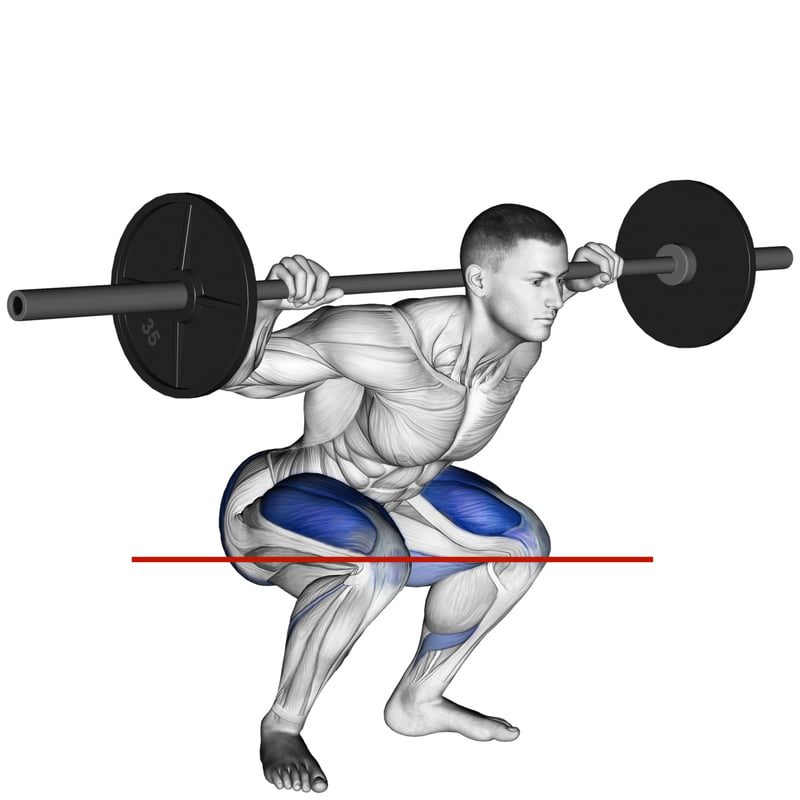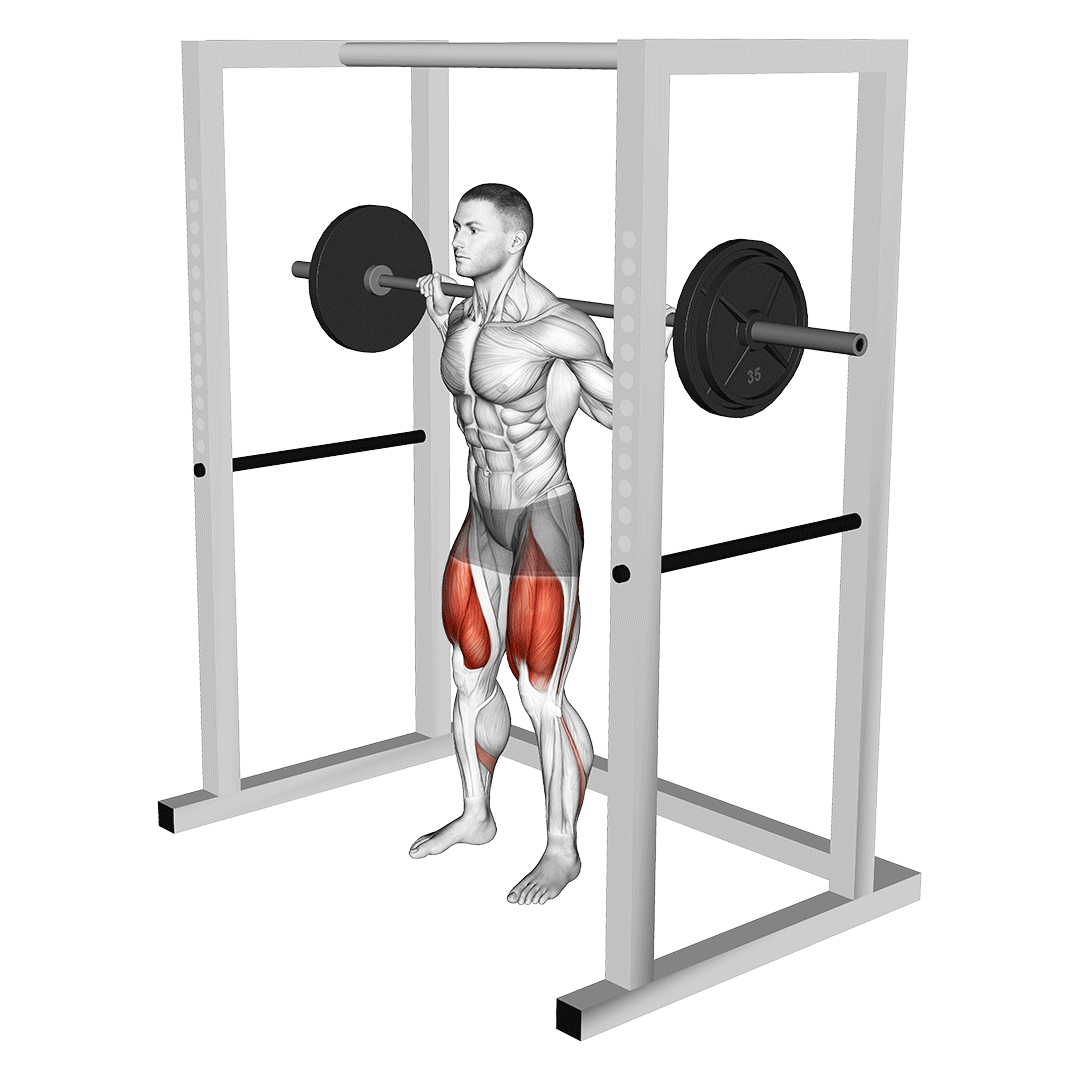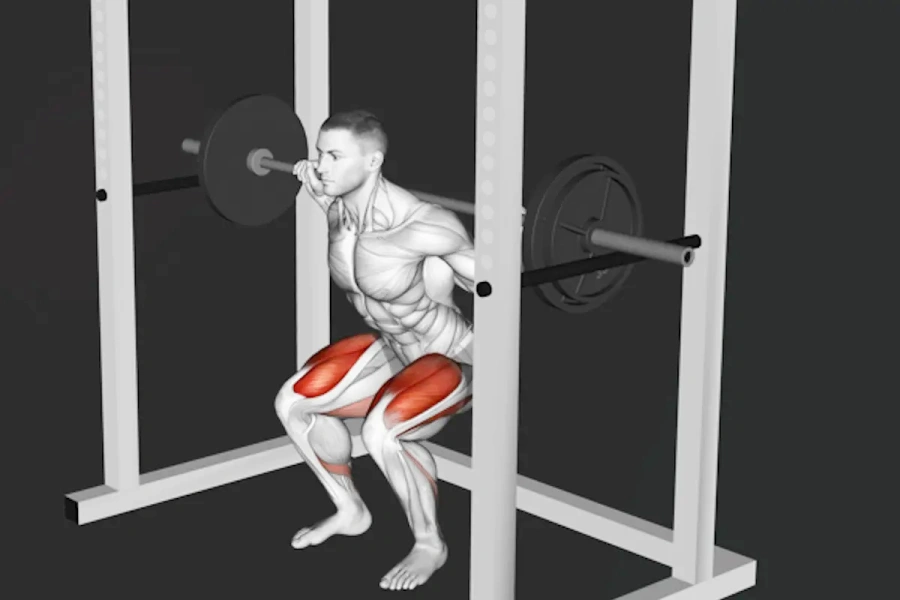Let’s get straight to the heart of every powerlifter’s anxiety: squat depth. I’ve stood on that platform, heart pounding, knowing a single inch could turn white lights to red. And I’ve coached athletes through that same gut-wrenching moment. The rule isn’t vague—it’s brutally specific. In powerlifting, a squat passes only when the hip crease drops below the top of the knee joint.
1. Legal Powerlifting Squat Depth
Forget vague ideas of “deep enough.” In powerlifting, the rule is crystal clear: the hip crease must descend below the top of the knee joint. Visualize this: from the side, if you drew a straight line across the very top of your kneecap, your hip crease – that deep fold where your upper thigh meets your torso – needs to drop below that line. This position is universally called “below parallel.”

- Below Parallel: This isn’t optional; it’s the standard across all major federations (IPF, USAPL, etc.). Your femur bone needs to dip below parallel to the floor. It’s the benchmark.
- Hip Crease is King: Don’t focus solely on your quads or butt. Judges are trained to watch that specific hip crease point. I tell my athletes to think about deliberately “showing” that crease to the side judge on the way down.
- The Visual Check: Imagine that line across your knee top. Your mission in the hole? Get that hip crease under it. Practice this in front of a mirror or get a video from the exact side angle. What feels deep enough often isn’t, especially under heavy weight. Trust me, I learned that the hard way missing my second attempt at my first regional meet with what felt like my deepest squat ever!
- No Shuffling: Here’s a crucial detail often overlooked: once you hit depth, you must stand up immediately without any downward movement, foot shifting, or rocking. That little readjustment you do in the gym? It’ll get you red lights on stage. You hit it, you drive. Period.
1.1 Why is Depth Important?
It’s simple, but profound. Correct depth ensures a full range of motion. Barbell Powerlifting isn’t about partial reps or shortcuts. It demands you move the weight through the complete, defined movement pattern. Hitting true depth:
- Validates the Lift: It meets the standard, plain and simple. No depth, no lift.
- Maximizes Muscle Activation: As research from sources like StrengthLog and clinical perspectives from places like Park North Physical Therapy emphasize, achieving full depth engages the entire posterior chain – glutes, hamstrings, adductors – and quads more completely than partial squats. You build stronger, more resilient legs overall.
- Builds Legitimate Strength: Strength through a full range is more functional and translates better to overall athleticism and injury resilience. Partial squats might let you move more weight, but they don’t build the same strength where it counts – deep in the hole where we’re often weakest.
2. Factors Affecting Your Powerlifting Squat Depth
So, why is hitting that magic spot sometimes so darn hard? It’s rarely just about effort. Here’s what I see trip up lifters (myself included years ago!):
| Factor | Impact on Depth | Prevalence | Key Symptom | Fix Priority |
|---|---|---|---|---|
| Ankle Dorsiflexion | Restricts knee travel → Forces torso lean | 89% of lifters | Heels rise prematurely | ★★★★☆ (Critical) |
| Hip Internal Rotation | Limits pelvic clearance → Causes butt wink or lumbar rounding | 78% of lifters | Groin "pinching" at depth | ★★★★☆ |
| Hip Flexor Tightness | Pulls pelvis anteriorly → Reduces hip socket clearance | 82% of lifters | Forward lean under load | ★★★☆☆ |
| Adductor Flexibility | Restricts stance width → Forces upright torso compromises | 68% of lifters | Knee cave + depth stall | ★★★☆☆ |
| Thoracic Mobility | Restricts upright posture → Shifts weight forward | 63% of lifters | Bar rolls up back | ★★☆☆☆ |
| Core Bracing Failure | Collapse under load → Depth instability | 91% of failed lifts* | Rib flare or hyperextension | ★★★★★ |
| Femur Length | Longer femurs = greater forward lean required | Anatomical | Depth only achievable wide-stance | ★☆☆☆☆ |
| Motor Control | Poor descent mechanics → Unbalanced weight distribution | 75% of novices | Depth inconsistencies | ★★★★☆ |
- Ankle Mobility (Dorsiflexion): If your ankles are stiff, your heels will lift, or your torso will pitch forward excessively as you descend, pulling you out of position before you hit depth. Try this: can you keep your feet flat and your knee travel well past your toes in a bodyweight squat? If not, ankles are likely a culprit.
- Hip Mobility (Internal Rotation & Flexion): Tight hips, especially in the capsule or surrounding muscles (hip flexors, adductors), physically block you from sinking deep without significant lumbar rounding or “butt wink.” This was my personal nemesis for years.
- Thoracic Spine Mobility & Core Bracing: A stiff upper back makes it hard to maintain an upright torso, forcing you forward. Poor core bracing means you lose stability and can’t control the descent effectively into depth. If you find yourself collapsing forward under load, look here.
- Anatomy: Bone structure (femur length, hip socket depth) plays a role. Some lifters have a naturally more favorable structure for deep squatting than others. This isn’t an excuse, but it is a factor requiring tailored solutions.
- Technique & Motor Control: Simply not understanding how to initiate the descent, control the eccentric, and stay balanced over mid-foot can prevent you from reaching depth efficiently. Are you breaking at the hips and knees together?
3. Powerlifting Squat Training Techniques for Depth Confidence
Building depth requires specific strategies woven into your training:

- Prioritize Depth Over Weight: Especially in the off-season or early prep phases. Use weights where you can consistently hit legal depth with good form. Leave ego at the door. Sacrificing depth for heavier weight on the bar is a dead end. I’d rather see an athlete hit 80kg perfectly deep than grind 100kg to questionable depth.
- Train to a Visual Target: Have a spotter, coach, or camera confirm depth on your heaviest sets. Use a box set to correct depth as a guide (touch-and-go, not sit!). In my home gym, I have a specific spot marked on the mirror I know signifies depth.
- Embrace Submaximal Volume: Doing more high-quality reps at challenging but submaximal weights (e.g., 70-85% of 1RM) at full depth builds the necessary strength-endurance and motor patterns better than constantly grinding near-max singles. 5×5 below parallel builds champions.
- Compete in Training: Mimic meet conditions. Have someone give you squat commands (“Squat” – “Rack”) and judge your depth occasionally. Practice the “no shuffling” rule religiously. This builds the discipline you need on the platform.
Hitting legal powerlifting squat depth isn’t just about satisfying judges; it’s the cornerstone of a strong, effective, and respected squat. It builds real strength through a full range of motion, maximizes muscle development, and validates your effort on the platform. It takes consistent work on mobility, technique, and targeted strength. Embrace the process. Diagnose your limitations, attack them diligently with the drills and techniques we’ve covered, and prioritize perfect depth over chasing numbers that don’t count.
Welcome! I’m Jordan Mitchell, the dedicated editor at Leadman Fitness, where we specialize in manufacturing high-quality bumper plates, barbells, weight machines, kettlebells, and dumbbells. With a passion for fitness and a keen eye for detail, I ensure that our product information is clear, accurate, and engaging for our customers. My role involves collaborating closely with our design and production teams to highlight the innovative features and superior craftsmanship that set Leadman Fitness apart in the industry. Whether you’re a professional athlete or a fitness enthusiast, I’m here to provide you with the information you need to achieve your training goals with our top-of-the-line equipment.
